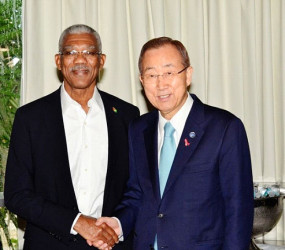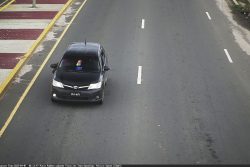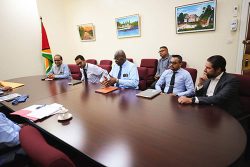Government of the Cooperative Republic of Guyana Address by Brigadier David Granger, MSS President of the Cooperative Republic of Guyana to the 11th Parliament, Georgetown, on 9th July 2015.
Mr Speaker;
Honourable Prime Minister and Leader of the House;
Honourable Members of the National Assembly;
Members of the Diplomatic Corps;
Ladies and gentlemen;
I have decided to address this Assembly on a matter of national importance in accordance with Article 67 (1) of the Constitution of Guyana. I wish to bring you abreast with the developments in relation to the Decrees that have been issued by the Bolivarian Republic of Venezuela and which have impinged on the exercise of Guyana’s sovereignty and our rights to our Exclusive Economic Zone.
President Nicolás Maduro Moros of the Bolivarian Republic of Venezuela reported on 6th July that he had “replaced” Decree No. 1.787 that purported to exercise sovereignty over waters it claimed from neighbouring states with Decree No. 1.859. President Maduro told the Venezuelan National Assembly:
“I have decided to take all the content of this decree 1787 to the State Council and the Supreme Tribunal of Justice (TSJ) and, in the meantime, taking the doctrinarian, constitutional criteria (…) issue a new decree to supersede it (the decree issued on May 27) in all its parts.”

President Maduro also announced the recall of Venezuela’s Ambassador to Guyana, for consultations, his decision to reduce the Venezuelan embassy staff in Georgetown and his directive to the Foreign Minister to review diplomatic relations with Guyana.
Decree No. 1.787 – published in Venezuela’s Official Gazette No. 40.669 and dated May 26, 2015 – had repeated that country’s baseless assertions that the entire western Essequibo was a zona en reclamación and restated its quest for a salida al Atlántico – access to the Atlantic. These two claims, on land and at sea, have been at the heart of Venezuela’s geopolitical strategy towards Guyana for over 50 years.
Unofficial maps, generated by the National Organi-sation for Rescue and Maritime Safety of the Aquatic Areas of Venezuela (Organización Nacional de Salva-mento y Seguridad Maritima de los Espacios Acuaticos de Venezuela – ONSA), a non-governmental organisation, indicate that the claim would encompass a large part of the maritime zone sited off the Demerara coast in which the US firm ExxonMobil discovered oil earlier in 2015.
Decree No. 1.787 created the notion of the “Atlantic coast of Venezuela.” This geographical fiction purports to justify the extension of that country’s sovereignty over Guyana’s territorial waters in the Atlantic Ocean off the territory of five regions of the Essequibo and over a distance of 200 nautical miles range thereby completely blocking Guyana’s access to its own exclusive economic zone. The Decree also created so-called “Areas of Integral Defense of Marine Zones and Islands,” extending sovereignty even into part of Suriname’s maritime space.
The Decree is like a fishbone in our throats. It violates the word and spirit of the 1966 Geneva Agreement that forbids the claiming of new territory while the Agreement remained in force. Article V of the Agreement states, inter alia:
No new claim, or enlargement of an existing claim, to territorial sovereignty in those territories shall be asserted while this Agreement is in force, nor shall any claim whatsoever be asserted otherwise than in the Mixed Commission while that Commission is in being.
The Venezuelan government, therefore, had no right, either under the Geneva Agreement or in international law to oppose exploratory activities by Exxon Mobil and its subsidiary Esso Exploration and Production (Guyana) Limited in the ‘Stabroek Bloc.’ Venezuela had no right to demand ‘prior notification’ owing to the fact that the specific area of operations in the Stabroek Bloc is located in a new maritime area over which sovereignty has been claimed by Venezuela.
The action taken by the Venezuelan Foreign Minister in February to write to the country manager of Esso Exploration and Production (Guyana) Limited and to object to the dispatch of a rig to proceed with the exploration for petroleum in accordance with the concession granted by the Government of Guyana, therefore, constituted an unnecessary and unlawful interference in Guyana’s sovereign jurisdiction.
Guyana’s sustained efforts to alert the international community of the adverse effects and to seek the repudiation of the Venezuelan unilateral and illegal delineation of maritime territory, not only in relation to the territory of Guyana, but other states in this hemisphere, have come to fruition.
Guyana has never used aggression against any State. Guyana has always embraced the principle of the peaceful settlement of disputes. But in as much as we are a peace-loving nation, we will not allow our territorial integrity to be threatened or violated. We consider Decree 1.787 as constituting an act of aggression against Guyana.
In response to the Decree, my government sought the solidarity of the regional and international Community. The Commonwealth was one of the communities to express its support for Guyana. The Commonwealth Secretary-General in a statement issued on his arrival in Guyana, recalled that at the last Commonwealth Summit held in Sri Lanka in 2013, the community had reaffirmed its “unequivocal support for the maintenance and preservation of Guyana’s sovereignty and territorial integrity.” The Secretary-General stated that “The Commonwealth remains steadfast in its support for the Government and people of Guyana.”
We have sought solidarity from the Caribbean Community. I have just returned from the 36th Regular Meeting of the Conference of the Heads of Government of the Caribbean Community. I am pleased to report that support for Guyana was overwhelming. I met personally with a number of leaders of the Region and they all pledged their continued support for Guyana. In the Final Communiqué issued by the Conference, the Heads indicated their deep concern over the decree because of its implications not just for Guyana but also for a number of other Caribbean states. The Conference called on the Bolivarian Republic of Venezuela, “to withdraw those elements of Decree No. 1.787 insofar as they apply to the territory and maritime space of CARICOM States.”
During the course of the Caricom Summit, I had the pleasure of meeting the Secretary-General of the United Nations, Mr Ban Ki-Moon. I shared with him Guyana’s position. He has committed to sending a mission to both Venezuela and Guyana. I thank him for this pledge and look forward to receiving his Mission to Guyana.
While the new Decree No. 1.859 does not contain the coordinates of Decree No. 1.787, it does contain a general description of all the defence zones, with the description of Eastern, Central, and Western regions, remaining consistent with previous versions of the Decree. It goes further to state that these ‘defence zones’ are spaces created to plan and execute integral defense operations. This portion remains offensive to Guyana since there continues to be a threat of the use of force in these areas.
The Co-operative Republic of Guyana therefore rejects the description of its maritime territory as a ‘defence zone’ of the Bolivarian Republic of Venezuela.
Guyana is a sovereign State. It is empowered under international law to exercise sovereign rights over its continental shelf and exclusive economic zone. Guyana has full and unfettered authority to unilaterally explore and exploit the living and non-living resources within its jurisdiction. Any objection to, or obstruction of, the exercise of such jurisdiction is contrary to international law.
The expulsion of an unarmed, seismic survey vessel from Guyana’s exclusive economic zone by a Venezuelan naval corvette, therefore, was a dangerous and egregious exhibition of gunboat diplomacy. The corvette — PC 23 Yekuana — of the Bolivarian Navy of Venezuela entered Guyana’s exclusive economic zone around 16:00 h on Thursday 10th October 2013 and, under the threat of force, prevented the unarmed vessel — Teknik Perdana — from conducting seismic surveys. The Yekuana incident was as extreme use of armed force. It violated the Charter of the United Nations. It threatened regional peace and security. It contradicted the promise of Presi-dent Nicolas Maduro Moros who, speaking at a public event in Nueva Esparta shortly after his visit to George-town in August 2013, solemnly promised:
“Any issues we have with our neighbourly countries, either serious or not, will be solved peacefully through the diplomatic channels and international law. There will never be war. We have declared South America the land of peaceful people…”
Venezuela has relentlessly claimed the entire Esse-quibo region of Guyana for over 50 years. It still insists on referring to the Essequibo in its publications and charts as the zona en reclamación. It still attempts to appropriate the waters off the Essequibo coast in defiance of international law. It still continues its policy of economic blockade of the Essequibo as it has always done:
- President Raúl Leoni Otero placed an advertisement in the Times newspaper of London on 15th June 1968 to the effect that the Essequibo belonged to Venezuela and that it would not recognise economic concessions granted there by the Guyana Government. He then issued Decreto No. 1.152 of 9th July 1968, purporting to annex a nine-mile wide belt of sea-space along Guyana’s entire Esse-quibo coast and requiring various agencies, including the Defence Ministry, to impose Venezuelan sovereignty over it.
- President Rafael Antonio Caldera Rodriguez blocked Guyana’s attempt to allow petroleum exploration rights in the Essequibo by DEMITEX, a German company.
- President Luis Herrera Campins reinforced the blockade by obstructing the development of the Upper Mazaruni Hydro-power Project. He issued a communiqué in April 1981 stating that, because of “Venezuela’s claim on the Essequibo territory,” it “asserted the rejection of Venezuela to the hydro-electric project of the upper Mazaruni.” Venezuela’s Foreign Minister, José Alberto Zambrano Velasco, wrote a letter giving the President of the World Bank an ultimatum to refrain from financing the Upper Mazaruni Hydro-Electric Project.
- President Carlos Andrés Pérez paid a visit to Guyana in 1978 during which he indicated Venezuela’s willingness to help finance the hydro-electric power project in the Cuyuni-Mazaruni Region of the Essequibo. Behind the apparent friendliness, however, the realpolitik of Venezuela’s geo-political interests remained unchanged. Perez frankly expressed Venezuela’s geopolitical interest in gaining a Salida al Atlantico – access to the Atlantic – from the Orinoco delta by offering to reduce the territorial claim to about 31,000 km2 in return for the Essequibo coast.
- President Jaime Ramón Lusinchi reaffirmed the claim of previous Presidents insisting that it could not be renounced.
- President Hugo Rafael Chávez Frias issued a July 2000 declaration to prevent the Beal Aerospace Corpora-tion from establishing a satellite station in the Barima-Waini Region and opposed the issuance of petroleum exploration licences to American companies off the Essequibo coast.
- President NicolásMaduro Moros by issuing Decree No. 1.787 and Decree No. 1.859 in 2015 has continued the attitude of his predecessors.
Guyana, therefore, has long recognised that Venezuela’s territorial claim has hindered the development of its five Essequibo regions through lost foreign investments and blocked projects. Guyana had to seek safety beneath the shelter of international law to guarantee its territorial security and attract foreign investment in a competitive international environment.
Guyana enacted the Maritime Boundaries Act, which determined that sovereignty “has always extended to the territorial sea and to the seabed and subsoil underlying and the airspace over such sea.” Guyana asserted that it had always had “full and exclusive sovereign rights in respect of the continental shelf.” The President made Order No. 19 of 1991 under the Act on 23 February 1991 declaring a specific area an ‘exclusive economic zone.’ The Act established a fishery zone beyond and adjacent to the territorial sea with an outer limit of 200 miles from the baseline of the territorial sea. This area coincided with that of the EEZ and served to ensure Guyana’s sovereignty over its living marine resources.
Guyana also enacted the Petroleum (Exploration and Production) Act, 1986. Licences have been issued under the Act, from time to time, for foreign companies to conduct exploration activities. All the areas in which foreign companies were granted licences to conduct exploration were located in Guyana’s waters. Bilateral fishing agreements allowing foreign vessels to fish in Guyana’s waters were also made without challenge or protest.
Guyana’s National Assembly enacted legislation and the Government made regulations which were enforced through the courts and by various arms of the state. Sovereignty and jurisdiction, therefore, were exercised openly and continuously by these executive actions by the state of Guyana.
The National Assembly later unanimously approved a resolution on November 10, 1993 which endorsed Guyana’s ratification of the United National Convention on the Law of the Sea (UNCLOS) and its deposit of the 60th Instrument of Ratification on November 16, 1993, enabling the Convention to enter into force a year later.
Venezuela’s claims to over 150,000 km² of Guyana’s land-space and a large part of its hydrospace have their origins in its rejection of the 1899 award of the international tribunal as a nullity. The land boundary, subsequent to the award, was surveyed and the details embodied on maps and certified by agreement of January 10, 1905.
Guyana will continue to pursue a wide range of diplomatic options as its first line of defence. Guyana remains resolute in defending itself against all forms of aggression. We remain wedded to the ideal of peace. We have never, as an independent state, provoked or used aggression against any other nation. We have never used our political clout to veto development projects in another country. We have never discouraged investors willing to invest in another country. We have never stymied development of another nation state. We do not expect, nor will we condone, any country attempting to do the same to us.
Guyana seeks friendly relations with its Continental neighbours and the Caribbean Community to develop its resources for the benefit of its people. We want the Caribbean to be a zone of peace.
Guyana has no interest or intention to be aggressive towards Venezuela, a country of 912,050 km2, more than four times the size of Guyana; a country with a population of more than forty times that of Guyana; a country with armed forces — the National Bolivarian Armed Forces — FANB – with more than twenty times as many members as Guyana’s Defence Force. How can Guyana launch an aggression against Venezuela?
The Government of Guyana expects the Government of the Bolivarian Republic of Venezuela to observe, fully, the 1897 Treaty, the 1899 Arbitral Award, the 1905 demarcation of the boundary between Guyana and Venezuela pursuant to the Arbitral Award, the 1966 Agreement and other formally ratified documents between the two states.
Our objective in the short term is to have all threats withdrawn. We shall be seeking a permanent juridical solution under the auspices of the Geneva Agreement and under international law, in the long term.
I look forward to the support of this National Assembly as we defend our right to exist, our right to development, our sovereignty and our territorial integrity.
I thank you








